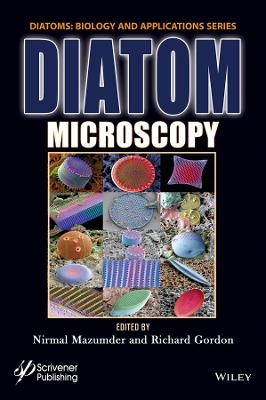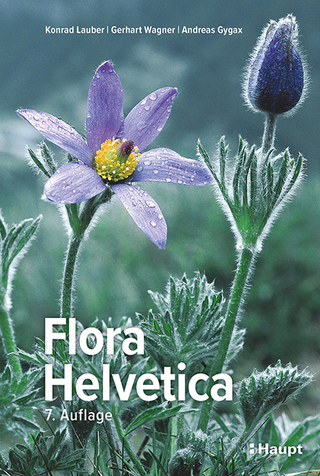
Diatom Microscopy
Wiley-Scrivener (Verlag)
978-1-119-71153-7 (ISBN)
This book on Diatom Microscopy gives an introduction to the wide panoply of microscopy methods being used to investigate diatom structure and biology, marking considerable advances in recent technology including optical, fluorescence, confocal and electron microscopy, surface-enhanced Raman spectroscopy (SERS), atomic force microscopy (AFM) and spectroscopy as applied to diatoms. Each chapter includes a tutorial on a microscopy technique and reviews its applications in diatom nanotechnology and diatom research. The number of diatomists, diatom research, and their publications are increasing rapidly. Although many books have dealt with various aspects of diatom biotechnology, nanotechnology, and morphology, to our knowledge, no volume exists that summarizes advanced microscopic approaches to diatoms.
Audience
The intended audience is academic and industry researchers as well as graduate students working on diatoms and diatom nanotechnology, including biosensors, biomedical engineering, solar panels, batteries, drug delivery, insect control, and biofuels.
Nirmal Mazumder obtained his PhD degree in 2013 from National Yang-Ming University, Taiwan. He has two years of post-doctoral research experience. In 2016, he joined the Department of Biophysics, Manipal School of Life Sciences, Manipal Academy of Higher Education, Manipal, India as an assistant professor. His research interests relate to the development of Stokes-Mueller-based light microscopy for tissue characterization and deep learning. He also investigates the photonics properties of diatoms as well as frustules for bio-photonics applications. He has published several peer-reviewed journal articles and book chapters. Richard Gordon’s involvement with diatoms goes back to 1970 with his capillarity model for their gliding motility, published in the Proceedings of the National Academy of Sciences of the United States of America. He later worked on a diffusion-limited aggregation model for diatom morphogenesis, which led to the first paper ever published on diatom nanotechnology in 1988. He organized the first workshop on diatom nanotech in 2003.
Preface xi
1 Investigation of Diatoms with Optical Microscopy 1
Shih-Ting Lin, Ming-Xin Lee and Guan-Yu Zhuo
1.1 Introduction 2
1.2 Light Microscopy 4
1.2.1 Phase Contrast Microscopy 4
1.2.2 Differential Interference Contrast (DIC) Microscopy 6
1.2.3 Darkfield Microscopy 9
1.3 Fluorescence Microscopy 10
1.4 Confocal Laser Scanning Microscopy 12
1.5 Multiphoton Microscopy 19
1.6 Super-Resolution Optical Microscopy 22
1.7 Conclusion 25
Acknowledgement 25
References 25
2 Nanobioscience Studies of Living Diatoms Using Unique Optical Microscopy Systems 33
Kazuo Umemura
Abbreviations 33
2.1 Trajectory Analysis of Gliding Among Individual Diatom Cells Using Microchamber Systems 35
2.2 Direct Observation of Floating Phenomena of Individual Diatoms Using a “Tumbled” Microscope System 40
2.3 Three-Dimensional Physical Imaging of Living Diatom Cells Using a Holographic Microscope System 44
Acknowledgements 47
References 47
3 Recent Insights Into the Ultrastructure of Diatoms Using Scanning and Transmission Electron-Microscopy 57
Dharshini Gopal, Shweta Chakrabarti, Dataram Venkata Srikar Keshav, Richard Gordon and Nirmal Mazumder
3.1 Introduction 58
3.2 Scanning Electron Microscopy (SEM) of Diatoms 58
3.3 Transmission Electron Microscopy (TEM) of Diatoms 65
3.3.1 Limitations 69
3.4 Conclusion 73
References 73
4 Atomic Force Microscopy Study of Diatoms 81
Ishita Chakraborty, Shweta Chakrabarti, Vishwanath Managuli and Nirmal Mazumder
4.1 Introduction 82
4.2 Types of AFM Modes 86
4.3 Sample Preparation and Methods 88
4.4 Study of Diatom Ultrastructure Under AFM 88
4.5 Conclusion 102
Glossary 104
Acknowledgement 104
References 105
5 Refractive Index Tomography for Diatom Analysis 111
Juan M. Soto, José A. Rodrigo and Tatiana Alieva
5.1 Introduction 112
5.2 Fundamentals of PC-ODT 113
5.3 Experimental Setup for PC-ODT 117
5.4 Diatom RI Reconstructions with Bright-Field Illumination 120
5.5 Illumination Impact on PC-ODT Performance 126
5.6 Concluding Remarks 131
Acknowledgement 134
References 134
6 Luminescent Diatom Frustules: A Review on the Key Research Applications 139
Jayur Tisso, Shruthi Shetty, Nirmal Mazumder, Ankur Gogoi and Gazi A. Ahmed
6.1 Introduction 140
6.2 Key Research Applications of Luminescence Properties of Diatom Frustules 141
6.2.1 Novel Nanophotonic and Optoelectronic Applications of Luminescent Diatom Frustules 142
6.2.2 Applications of Diatom Luminescence in Sensing 145
6.2.3 Biomedical Applications of Diatom Luminescence 149
6.2.4 Other Studies on Diatom Luminescence 151
6.3 Future Perspectives 167
6.4 Conclusion 168
Acknowledgement 168
References 168
7 Micro to Nano Ornateness of Diatoms from Geographically Distant Origins of the Globe 179
Mohd Jahir Khan, Daniel Mathys and Vandana Vinayak
7.1 Introduction 180
7.2 Materials and Methods 183
7.2.1 Diatom Samples and Microscopy 183
7.2.1.1 By Michael J. Stringer 183
7.2.1.2 Diatom Oamaru Slides by Diane Winter 184
7.2.1.3 By Daniel Mathys 184
7.2.1.4 Diatom Sampling, Slide Preparation and Imaging from Himalayas, Plains and Arabian Sea, India 185
7.3 Diatoms from Different Geographical Origins of the World 185
7.3.1 Oamaru Diatoms 185
7.3.2 Diatom Images Gifted by Michael J. Stringer 186
7.3.3 Diatoms from Natural History Museum Basel, Switzerland a Piece of Art by Daniel Mathys 190
7.3.4 Diatoms from India 193
7.4 Conclusion 216
7.5 Acknowledgements 216
References 216
8 Types of X-Ray Techniques for Diatom Research 221
Mridula Sunder, Neha Acharya, Smitha Nayak, Richard Gordon and Nirmal Mazumder
8.1 Introduction 221
8.2 Applications 222
8.2.1 Synchrotron Radiation-Based X-Ray Techniques 222
8.2.2 X-Ray Computed Tomography 224
8.2.3 X-Ray Fluorescence-Based Techniques 226
8.2.4 X-Ray Microanalysis 227
8.2.5 X-Ray Absorption-Based Techniques 228
8.2.6 X-Ray Diffraction 229
8.2.7 Other X-Ray-Based Techniques 230
8.3 Conclusions 233
Glossary 233
References 234
9 Diatom Assisted SERS 237
Rajib Biswas and Sankar Biswas
9.1 Introduction 237
9.2 Diatom 239
9.2.1 Basic Overview 239
9.2.2 Physiological Characteristics 239
9.2.3 Optical and Relevant Properties 240
9.3 Raman Scattering 241
9.3.1 Basics 241
9.3.2 Surface Enhanced Raman Scattering 242
9.3.3 Optoelectronic Investigations 242
9.4 SERS Through Diatom: Fundamentals and Application Overview 243
9.5 Conclusion and Future Outlook 245
References 246
10 Diatoms as Sensors and Their Applications 251
Priyasha De and Nirmal Mazumder
10.1 Introduction 251
10.2 Diatoms as Biosensors 255
10.2.1 Electrochemical Sensors 260
10.2.2 Plasmonic Sensors 261
10.2.3 Immunoassay Sensors 264
10.2.4 Optical and Optofluidic Sensors 268
10.2.5 Biochemical Sensors 271
10.2.6 FRET-Based Sensors 273
10.2.7 Microfluidics-Based Sensors 274
10.3 Conclusion 276
Acknowledgments 276
References 277
11 Diatom Frustules: A Transducer Platform for Optical Detection of Molecules 283
Viji S., Ponpandian N. and Viswanathan C.
11.1 Introduction 284
11.2 Optical Properties of Diatom Frustules 285
11.2.1 Diatom as a Photoluminescent Materials 285
11.2.2 Diatom as a Photonic Crystal 287
11.2.3 Diatoms as a SERS Substrate 288
11.3 Methods Involved in Thin Film Deposition of Diatom Frustules 290
11.4 Diatom as an Optical Transducer for Biosensors 294
11.5 Diatom as an Optical Transducer for Gas/Chemical Sensors 297
11.6 Conclusion 300
References 301
12 Effects of Light on Physico-Chemical Properties of Diatoms 307
Janardan Sen, Priyal Dhawan, Priyasha De and Nirmal Mazumder
12.1 Introduction 308
12.2 Effect of Light on Diatom Function and Morphology 310
12.2.1 Effect of Light Intensity on Diatom Morphology 310
12.2.2 Effect of Light Intensity on Diatom Growth 313
12.2.3 Effect of Light Intensity on Photosynthesis in Diatoms 318
12.2.4 Effect of Wavelength of Light on Diatom Pigment System 321
12.2.5 Effect of Light Intensity on the Physiology of Diatoms 327
12.3 Conclusion 330
Acknowledgment 330
References 330
Index 335
| Erscheinungsdatum | 24.06.2022 |
|---|---|
| Reihe/Serie | Diatoms: Biology and Applications |
| Sprache | englisch |
| Maße | 10 x 10 mm |
| Gewicht | 454 g |
| Themenwelt | Naturwissenschaften ► Biologie ► Botanik |
| Naturwissenschaften ► Biologie ► Limnologie / Meeresbiologie | |
| Technik ► Maschinenbau | |
| ISBN-10 | 1-119-71153-3 / 1119711533 |
| ISBN-13 | 978-1-119-71153-7 / 9781119711537 |
| Zustand | Neuware |
| Haben Sie eine Frage zum Produkt? |
aus dem Bereich


